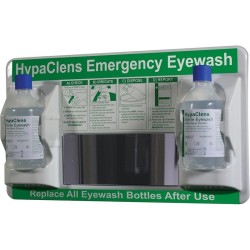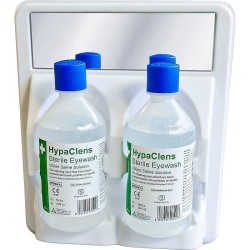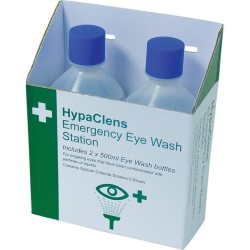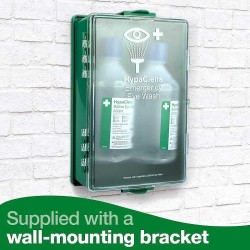Eyewash Stations
There are 4 products.
Active filters
About Eyewash Stations
Fixed Emergency Eye Irrigation for Immediate Chemical Response
Eyewash stations provide dedicated fixed or portable emergency eye irrigation equipment enabling immediate comprehensive eye washing following chemical splashes or contamination across laboratories, chemical handling facilities, manufacturing sites, and high-risk environments throughout England, Scotland, Wales, and Northern Ireland. These essential safety installations comprise wall-mounted or freestanding units delivering sterile irrigation solution through eye cups or nozzles, supporting immediate prolonged eye irrigation critical for chemical injury outcomes. High-risk organisations rely on eyewash stations for immediate chemical splash response, sustained eye irrigation capability, regulatory compliance particularly COSHH requirements, professional safety demonstration, and dedicated emergency response infrastructure. Modern eyewash stations incorporate features including readily accessible mounting positions, clear signage indicating locations, sufficient irrigation solution volumes, appropriate flow rates for effective washing, and user-friendly activation. The provision of eyewash stations demonstrates commitment to eye safety particularly in chemical environments, supports immediate sustained irrigation critical for chemical injury management, fulfils regulatory obligations, and enables professional emergency response across environments with significant chemical splash risks.
The implementation of eyewash stations directly supports workplace eye safety, chemical emergency response capability, and regulatory compliance in hazardous environments. Chemical eye injuries require immediate prolonged irrigation, with treatment delay significantly affecting outcomes including potential vision loss. Eyewash stations address these critical requirements by providing immediate irrigation capability at incident locations, enabling sustained washing removing contaminants, delivering appropriate solution volumes and flow rates, demonstrating regulatory compliance particularly COSHH requirements for chemical handling, and supporting professional emergency response. Applications include chemical laboratories requiring immediate splash response, manufacturing facilities with chemical processes, cleaning operations using hazardous substances, battery handling areas with acid splash risks, and workplaces with identified significant chemical eye hazards. Organisations benefit from eyewash stations through enhanced chemical injury outcomes via immediate sustained irrigation, demonstrated regulatory compliance, reduced liability through appropriate safety provision, and professional safety culture. Modern eyewash stations incorporate features such as hands-free operation, tempered water where plumbed, and testing mechanisms throughout England, Scotland, Wales, and Northern Ireland.
Selecting and implementing eyewash stations requires comprehensive chemical risk assessment, appropriate station specification, and integration with emergency response protocols across organisations throughout the UK. Safety managers should conduct thorough chemical risk assessments identifying splash hazards, determine required station locations based on hazard proximity and access time typically within ten seconds or ten metres, evaluate plumbed versus self-contained systems, and consider regulatory requirements particularly COSHH. Station selection should prioritise appropriate type with wall-mounted stations for fixed locations or portable units for flexibility, adequate irrigation volume and duration meeting standards typically fifteen minutes, suitable activation mechanisms enabling immediate hands-free use, appropriate mounting ensuring accessibility, and regulatory compliance. Implementation protocols must encompass strategic positioning near chemical hazards, clear signage indicating locations, staff training on eyewash station use, eye injury emergency procedures emphasising immediate irrigation, and documented maintenance. Quality assurance measures should include regular functional testing particularly for plumbed stations, documented inspection and testing schedules, solution replacement for self-contained units, maintenance ensuring continued functionality, and incident recording. Modern eyewash station management incorporates digital testing logs and preventive maintenance. Organisations should establish eye injury emergency procedures, integrate eyewash stations with broader chemical safety management, and maintain comprehensive documentation. Staff education should address eyewash station locations, immediate activation during chemical splashes, sustained irrigation importance typically fifteen minutes, and emergency services notification. Environmental considerations should ensure unobstructed access, appropriate drainage, and adequate lighting. By implementing eyewash stations alongside professional protocols, organisations throughout England, Scotland, Wales, and Northern Ireland demonstrate commitment to workplace eye safety in chemical environments, regulatory compliance with COSHH requirements, professional emergency response capability, and provision of critical infrastructure supporting optimal chemical eye injury outcomes across all workplaces with significant chemical splash hazards.




